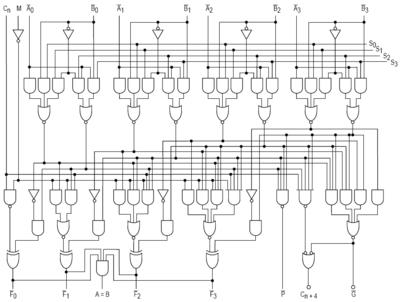| Selection | Active-low data | Active-high data |
| Logic M = H | Arithmetic M = L | Logic M = H | Arithmetic M = L |
| S3 | S2 | S1 | S0 | | Cn = L (no carry) | Cn = H (carry) | | Cn = H (no carry) | Cn = L (carry) |
| L | L | L | L |  |  minus minus  |  |  |  |  plus 1 plus 1 |
| L | L | L | H |  |  minus minus  |  |  |  |  plus plus  |
| L | L | H | L |  |  minus minus  |  |  |  |  plus 1 plus 1 |
| L | L | H | H | Logical 1 |  (two's complement) (two's complement) |  (zero) (zero) | Logical 0 |  (two's complement) (two's complement) |  (zero) (zero) |
| L | H | L | L |  |  plus plus  |  plus plus  plus plus  |  |  plus plus  |  plus plus  plus plus  |
| L | H | L | H |  |  plus plus  |  plus plus  plus plus  |  |  plus plus  |  plus plus  plus plus  |
| L | H | H | L |  |  minus minus  minus minus  |  minus minus  |  |  minus minus  minus minus  |  minus minus  |
| L | H | H | H |  |  |  plus plus  |  |  minus 1 minus 1 |  |
| H | L | L | L |  |  plus plus  |  plus plus  plus plus  |  |  plus plus  |  plus plus  plus plus  |
| H | L | L | H |  |  plus plus  |  plus plus  plus plus  |  |  plus plus  |  plus plus  plus plus  |
| H | L | H | L |  |  plus plus  |  plus plus  plus plus  |  |  plus plus  |  plus plus  plus plus  |
| H | L | H | H |  |  |  plus plus  |  |  minus 1 minus 1 |  |
| H | H | L | L | Logical 0 |  plus plus  |  plus plus  plus plus  | Logical 1 |  plus plus  |  plus plus  plus plus  |
| H | H | L | H |  |  plus plus  |  plus plus  plus plus  |  |  plus plus  |  plus plus  plus plus  |
| H | H | H | L |  |  plus plus  |  plus plus  plus plus  |  |  plus plus  |  plus plus  plus plus  |
| H | H | H | H |  |  |  plus plus  |  |  minus minus  |  |







































